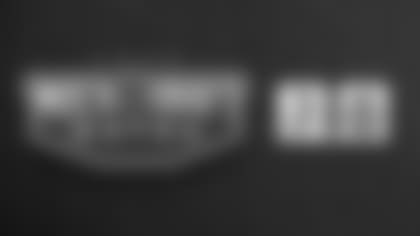Every summer leading up to training camp Buffalobills.com asks 25 of the most pressing questions facing the team as they make their final preparations for the upcoming regular season. With a new regime and practices at St. John Fisher fast approaching, here is the latest installment as we closely examine some of the answers the Buffalo Bills have to come up with between July 28th and Sept. 12th
It's a dramatic change in philosophy for Buffalo's defense for 2010. After nine years as a 4-3 front, the Bills are moving back to the 3-4 of their glory days in the hopes of building their defense back into a respected power. The players have been committed to the scheme change from the very beginning of offseason workouts this past spring, and head coach Chan Gailey is encouraged by the progress he's witnessed to this point.
"I think the players have adapted really well," said Gailey. "We have people that fit the defense and it's worked out with the additions we made, we've really strengthened our football team for the 3-4 defense. And I think they have a great understanding of the defense right now. It's not easy. They still have to work at it, but I think they've adjusted very well."
"We're all in this like a new team," said Marcus Stroud. "We're all going out there together and learning plays together, and by the time the season starts hopefully everybody will be right where they need to be and things will start clicking at the right time."
Playing effectively and consistently at game speed is the next step, and change for the better, as any football coach will tell you, does not happen overnight. That's what a month of training camp and four preseason games will serve to accomplish.
Each positional unit defensively for the Bills has adjustments to make in the new system from alignments to assignments to pre-snap checks and reads. Every position group has done their level best to adapt quickly, but which unit stands the best chance of assimilating the fastest?
Defensive lineBuffalo's defensive front obviously will have one less down lineman, in most cases, than they've had in the past. It immediately shifts more gap responsibility to the three men on the line of scrimmage. The nose tackle is often covering two gaps the most, but both defensive ends will be responsible for handling two gaps as well a fair amount of the time as they grind at the line with opposing offensive linemen.
For Stroud, a 10-year veteran, it's a whole new ball game.
"I've been running a 4-3 all my life and we have a lot of different calls," he said. "It's almost like being a rookie again. We're re-learning all the terminology and all the play calls. It's a work in progress, but I really believe that once we get everything down we'll definitely have a chance. And I think we'll be better than what people are giving us credit for."
The line has its share of veterans in Stroud, Dwan Edwards, who has 3-4 experience, Spencer Johnson and Kyle Williams. The rest of the group however, is largely unproven. With the degree of rotation that most NFL defensive lines employ in games to keep players fresh, there figures to be a bit of a learning curve. And that's not only for the younger reserves, but the veterans that are adjusting to the new scheme and its responsibilities.
LinebackersPerhaps no other position group on the defensive side of the ball will experience more change in responsibility than the linebacking corps.
"There's no other way to say it than the differences between the 4-3 and the 3-4 are night and day," said Paul Posluszny. "Just the way we fit up the run, coverages that we'll run. It's completely new compared to what and how we did things the last several years. I would say in all aspects of the game run and pass it's completely different. You have different guys dropping into coverage, different guys have different responsibilities, you have more linebackers on the field. The whole thing is just a new feel."
No one is feeling newer than Buffalo's defensive ends that have been converted to outside linebacker like Chris Ellis and Chris Kelsay. Aaron Maybin is also making the switch, but at 250 pounds he doesn't have quite as much weight to move around in space as his teammates.
"It's a big difference from last year," said Ellis. "We have so many different looks and that's just the base package. So when we get to a point where we can switch things up within the package of plays we already have and give some different looks, it's really going to challenge us as much as opposing offenses. It's a lot to take in, but it gives your defense and our position so many more options because we're asked to cover, stand up, be down, rush. It gives you everything."
Ellis and Kelsay both admit that the toughest transition is the coverage aspect, as they'll be counted on to cover tight ends and backs at times. Both improved as the spring wore on, and they're hopeful their progress continues once they're carrying their pads around as well.
Like the defensive line the linebacking corps has some experienced vets like Andra Davis, Keith Ellison, Kawika Mitchell and Posluszny. But there is a myriad of changes they must master between now and the regular season.
SecondaryIn this transition to the 3-4 defensive scheme Buffalo's secondary appears to be the unit that coordinator George Edwards could be leaning on the most. Not only does the defensive backfield have veteran starters, but veteran depth as well.
What's more the unit is unchanged from last season when the Bills defense ranked second in the league and first in the AFC in interceptions.
"The core group of guys we have back there have been playing together for three, some four years," said George Wilson. "After the season we had last year where we had a lot of injuries and a lot of guys had a lot of opportunities to get playing experience, that just gave us a bigger and better chemistry in the room."
Wilson was one of those beneficiaries making 12 starts at strong safety last season while posting a career-high four interceptions.
Perhaps even more significant is while there are different techniques and leverages employed in Buffalo's new defensive scheme, coverages in the NFL largely employ the same concepts. It's just a matter of how often they're used and how they're disguised.
In Buffalo's new defense the defensive backs are expected to play more man-to-man defense, something that was not implemented all that much in their previous scheme.
"We previously played the 'Tampa 2' and it's just spot dropping and breaking on the football," said Donte Whitner. "Now everything that we do basically turns into man. We've always had the athletes to play man and, but we never really did it. We did it in practice, but we'd never do it in the game. Now we're doing it from day one and we're playing man up on guys and the safeties are playing with the opportunity to jump a couple of those routes. We're liking it."
What should help the most in putting the Bills secondary on the fast track in the new scheme is their familiarity of playing with one another.
"There's that unspoken language where we can just look at each other or give a hand signal or give each other the eye contact and we know what to expect from the other guy," said Wilson.
"We don't even have to say anything," said Bryan Scott. "We actually had a play in practice this spring where we made the completely wrong call, but Drayton (Florence) and I still knew exactly what to do and were ready to go and we kind of looked at each other after the play and just said, 'Vet savvy.' I think we're going to be pretty good this year."
So although defensive coordinator George Edwards will have his men as prepared as possible for the Sept. 12 opener in their new look defense, his secondary with their playing experience together and impressive depth could be the key to helping his unit get off to a good start.
"We know as a secondary if we have a bad day it's probably going to be a bad day for the whole team," said Wilson. "So we play with that pressure on us. That's what motivates us and drives us each and every day. We accept that challenge and accept that role and embrace it at the same time."





